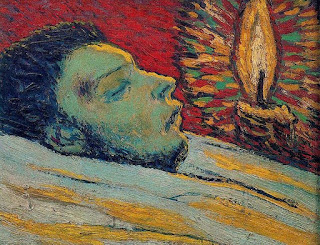Picasso exhibitions are rife across Europe this year. According to The Times there have been 21 exhibitions dedicated to his work alone in various locations across France, and as many more in neighbouring countries. In London we have had - Picasso 1932- Love, Fame, Tragedy at Tate Modern (here), and last year - Picasso Minotaurs and Matadors (here), and Picasso Portraits (here). You could be forgiven for thinking that this is overkill. Critics believe we are overdosing on Picasso with museum directors accused of creating substandard exhibitions because people will visit solely on the strength of Picasso's name alone. Claude Picasso the artist's son certainly agrees complaining that the Picasso Museum in Paris has been stripped of work, and that said works could be damaged in transit to the numerous exhibitions. "Among the exhibitions held there are many that are not necessary, and as a result people coming to the Picasso Museum are not finding the masterpieces they expect and to which they have a right" he has claimed.
This said however, one of the reasons for my visit to Paris on this occasion was this huge retrospective of Picasso's Blue and Rose periods. This magnificent exhibition could certainly not be accused of being one of those substandard exhibitions with pretentions and tenuous links to aspects of Picasso's oeuvre. This is a weighty exhibition exploring a crucial period of his work in which he becomes the artist we have grown to recognise as perhaps the most important of the twentieth century. It is a period of his development that I particularly enjoy, and though steeped in the artists personal circumstances of sadness, mourning and poverty, it was a fascinating and fertile period that produced many of his iconic pieces of art. Many of these works have been seen before at the Courtauld six years ago in - Becoming Picasso: Paris 1901 (here) - this exhibition though is a vastly expanded one to that seen at the Courtauld covering the years 1900-1906. Although I was familiar with many of the works from reproductions, the Courtauld show, and other subsequent Picasso exhibitions, this show is bolstered by a few works which haven't been seen in Paris since they were created, and others which have travelled from as far away as America. It was a great opportunity to experience them first-hand, and what a joy to observe them not only in the very city in which many of them were created over a hundred years ago, but also in the very place - the former train station, the Gare D'Orsay - where Picasso first arrived in Paris, in its new incarnation as one of the worlds most important museums - the Musée D'Orsay.
Femme à l'éventail (Lady with a Fan), 1905
Lady with a Fan, above is the first painting to greet visitors to the exhibition. She looks so statuesque and regal, her gesture and being reminisicent of a carved Egyptian hieroglyph. And as you move through the various rooms you are stunned not just by Picasso's stylistic shifts, but also his precocity and proliflicacy. He was definately a man on a mission with something to prove. The exhibition charts his influences as he shifted between Barcelona and Paris and the onset of the Blue Period - sparked by the death of his friend Casagemas, and the shift to depicting harlequins and circus folk, culminating with the emergence of a brighter palette in the Rose Period. Full marks to the curators for being able to secure his masterpiece of this period - La Vie for this exhibition, and also Young Girl With a Flower Basket, which raised $115 million at auction in June earlier this year. How amazing that in 1907, the very next year after the marvelous works created in the Blue and Rose Periods, his work would undergo another stylistic shift captured in Les Demoiselles D'Avignon as he went on to develop Cubism. Picasso: Bleu et Rose has to be the best exhibition I have visited so far this year.
Yo Picasso, 1901
Cafe Concert du Paralelo, 1900
Jeanne, 1901
Femme en Bleu, 1901
Portait of Gustave Coquiot, 1901
Child With a Dove, 1901
L'Attente (Margot), 1901
La Buveuse D'Absinthe (Absinthe Drinker), 1901
Seated Harlequin, 1901
Harlequin and His Companion, 1901
La Buveuse D'Absinthe (Absinthe Drinker), 1901
La Buveuse D'Absinthe (Absinthe Drinker), 1901
The Death of Casagemas, 1901
The Death of Casagemas, 1901
Self Portrait, 1901

Deux Femmes au Bar, 1902
Femme et Enfant au Bord de Mere (Mother and Child on the Shore), 1902

Deux Femmes au Bar, 1902
Femme et Enfant au Bord de Mere (Mother and Child on the Shore), 1902
L’Étreinte (The Embrace), 1903
L’Étreinte (The Embrace), 1903
Femme Assise (Melancholy Woman), 1903
Celestine, 1903
La Vie (Life), 1903
Le Repas de L'aveugle (The Blind Mans Meal), 1903
Le Repas Frugal, 1904
Les Deux Amies, 1904
Nu assis (Madeleine) (Seated Nude), winter 1904-1905
Girl in a Chemise, 1905
Fillette à la corbeille fleurie (Young Girl With a Flower Basket), 1905
Acrobate à la Boule (Acrobat on a Ball), 1905
Famille au Singe (Acrobat's Family with a Monkey), 1905
Acrobate et jeune Arlequin (Acrobat and Young Harlequin), 1905
Arlequin Assis Sur Un Canape Rouge (Harlequin Sitting on a Red Couch), 1905
Les Deux Frères (The Two Brothers), 1905-6
Les Deux Frères (The Two Brothers), 1906
Jeune garçon au cheval (Boy Leading a Horse), 1905-6
Self Portrait, 1906
La Coiffure, 1906
Nu Aux Mains Jointes (Woman With Her Hands Clasped), 1906
Nu Sur Fond Rouge, c.1906
The Toilette, Autumn, 1906
Two Nudes, sketch 1906
Two Nudes, 1906
Picasso Rose et Bleu
until 6th January
The Musée d'Orsay
1 Rue de la Légion d'Honneur,
75007 Paris,
France





















































